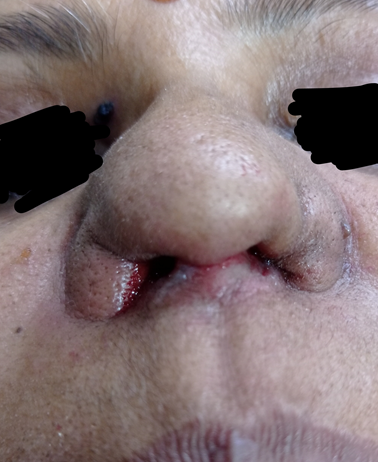- Visibility 93 Views
- Downloads 15 Downloads
- DOI 10.18231/j.ijashnb.2021.016
-
CrossMark
- Citation
Chipmunk facies’ in treated post-covid rhino-orbito-cerebral mucormycosis cases
- Author Details:
-
Abhimanyu Kadapathri *
-
Vaibhav Shandilya
-
Karampreet Singh
Mucormycosis as a sequelae of clinical event post COVID-19 infection caused by a filamentous fungus (class: Zygomycetes and order: Mucorales) has been termed Covid-associated mucormycosis (CAM). India in particular has seen a recent surge in cases associated with high morbidity and mortality. Since the onset of the COVID 19 pandemic there have been multiple reports across country of very high incidence of mucormycosis among patients with COVID 19 especially in those who are diabetic and those who have received steroids. (1) Published literature showed various observations linked to mucormycosis such as long term systemic steroid usage, long term hypoxia, uncontrolled diabetes, longer ICU stay etc.[1], [2], [3], [4] The sudden surge in mucormycosis patients during the worst hit phase by COVID-19 2nd phase in India lead to extreme difficulty in prioritising treatment for these patients. SARSCoV2 variant (B.1.1.7 & B.6.117) was the most prevalent one during second phase.[5] In-silico studies have shown stable interaction between RBD domain of spike protein (C480-488,) and GRP 78 predicting its role in endocytosis[6], [7] coat protein CotH3 of mucor favours similar pathway of entry through GRP78 into nasal and paranasal sinus mucosa. Over expression of GRP78 in these patients may be related to dexamethasone induced, endoplasmic reticulum stress induced or due to increased iron and high glucose,[7], [8], [9] there is further need for studies in GRP 78 expression context.
Procurement and administration of liposomal amphotericin B has become extremely difficult. Although we tried to stick to management guidelines suggested by European Confederation of Medical Mycology,[10] we as well as many Indian centres couldn’t stick to it as we were facing logistics issues. Our centre has successfully managed 35 cases of mucormycosis. We would like to report the structural complications in nasal pyramid post endoscopic denker’s procedure in mucormycosis survivors. Out of 35 treated cases 25 survived and completed 45 day followup. We had endoscopically addressed 22 of those survivors modified denker’s approach. Nasal structure related complications were found in 2 of these patients, 1 patient has partial stenosis + alar notching while other had alar notching only. These patients were planned for aesthetic surgery after completing their course of posaconazole.



During the denker’s approach, these patients required additional drilling of fronto-nasal process of maxilla to improve access to anterior and lateral most extent of maxillary sinus. Functional problem associated with this complication is the obliteration and loss of pliability of the nasal valve. Anatomically the internal nasal valve area borders are the septum, pyriform aperture floor, and head of the inferior turbinate and the caudal border of the upper lateral cartilage. The pyriform aperture region of the nasal valve has been found to have the smallest cross sectional area of the whole nasal valve and 2/3rd of nasal resistance is also in that area.[11]
We would like to report these cases to make an understanding in the rhinology community that many of mucormycosis survivors would need cosmetic treatments in the coming months. On the verge of a third wave lurking around the corner, close followup of previously treated patients and preparedness for future flock of mucormycoses is of utmost importance.
Conflict of Interest
The authors declare that there are no conflicts of interest in this paper.
References
- A K Singh, R Singh, S R Joshi, A Misra. Mucormycosis in COVID-19: A systematic review of cases reported worldwide and in India. Diabetes Metab Syndr Clin Res Rev 2021. [Google Scholar]
- S M Revannavar, P Supriya, L Samaga, K Vineeth. COVID-19 triggering mucormycosis in a susceptible patient: A new phenomenon in the developing world?. BMJ Case Rep 2021. [Google Scholar] [Crossref]
- S A Ravani, G A Agrawal. Rise of the phoenix: mucormycosis in COVID-19 times. Indian J Ophthalmol 2021. [Google Scholar] [Crossref]
- J Hernández, C J Buckley. Mucormycosis. Treasure Island (FL). StatPearls Publishing. 2021. [Google Scholar]
- G Vaidyanathan. Coronavirus variants are spreading in india - what scientists know so far (News in Focus). Nature 2021. [Google Scholar] [Crossref]
- M S Graham, C H Sudre, A May. Changes in symptomatology, reinfection, and transmissibility associated with the SARS-CoV-2 variant B.1.1.7: an ecological study. Lancet Public Heal 2021. [Google Scholar] [Crossref]
- A A Elfiky, I M Ibrahim, A E Elgohary. Host-cell recognition through GRP78 is enhanced in the new variants of SARS-CoV-2. Res Sq 2021. [Google Scholar] [Crossref]
- A K Banerjee, F Begum, A K Srivastava. Overexpression of GRP78 receptor and its chemical biology in cancer and autoimmune diseases: high risk for COVID 19? . OSF Prepr 2020. [Google Scholar]
- R Sabirli, A Koseler, T Goren. High GRP78 levels in Covid-19 infection: a case-control study. Life Sci 2021. [Google Scholar] [Crossref]
- O A Cornely, A Alastruey-Izquierdo, D Arenz, Sca Chen, E Dannaoui, B Hochhegger. Global guideline for the diagnosis and management of mucormycosis: an initiative of the European Confederation of Medical Mycology in cooperation with the Mycoses Study Group Education and Research Consortium. Lancet Infect Dis 2019. [Google Scholar]
- W Smith, D Lowe, P Leong. Resection of pyriform aperture: a useful adjunct in nasal surgery. J Laryngol Otol 2009. [Google Scholar]
